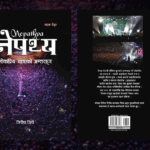The Digital Nepal Framework (DNF) has been seen as an ambitious approach by the government for raising digital literacy and supporting the advancement of ICT in Nepal. The framework has been developed as a roadmap for how digital efforts can contribute to economic growth. It also seeks to find new solutions to address important societal concerns efficiently and identify chances for Nepal to engage in the global economy. The DNF includes 80 activities divided into eight categories – digital foundation, agriculture, health, education, energy, tourism, finance and urban infrastructure.
Despite encouraging a surge in ICT growth in the recent years, particularly in the wake of the ‘digital’ frenzy, the government had yet to make a significant and concrete contribution. Nonetheless, three years after Nepal adopted the Digital Nepal Framework, the project seems to be finally getting some attention from the government as the Ministry of Communications and Information Technology (MoCIT) recently announced an investment of NPR 22 billion in the project. The World Bank is set to invest NPR 17 billion and provide NPR 5 billion as business loans for the project. The ministry has so far prepared a draft of the scope for investment in the Digital Nepal Framework and is currently seeking suggestions from all stakeholders. As per MoCIT, a portion of the amount would be used for funding internet expansion in rural areas, and provide Internet Service Providers (ISPs) financial incentives to develop weather-resistant high-speed broadband connectivity. Similarly, the government plans to invest in e-governance, which would comprise of digital signatures, a cybersecurity regulatory framework, and an increased capacity of current data centers.
Status of the Digital Nepal Framework
Digital Foundation: The Digital Foundation dimension of the Digital Nepal Framework focuses on three pillars: Digital Connectivity, Digital Skills, and Digital Governance. Digital Connectivity has seen an exponential rise as Mobile and Internet penetration in Nepal has increased dramatically in recent years. As per the Nepal Telecommunications Authority, the total broadband penetration in Nepal is 126.72% (97.42% mobile broadband and 29.30% fixed broadband) as of mid-February 2022. Over 1.97 million households in Nepal have internet subscriptions. The government is also moving forward with the testing of 5G technology. However, challenges such as affordability, digital divide, access, and digital illiteracy, still remain in many parts of Nepal. In regard to Digital Governance, the government has made some efforts to digitalize public services, such as the digitization of data of land revenue offices, the launch of the Nagarik App, launch of the Nepal National Single Window (NNSW) system, the National ID card, etc. to name a few. Nevertheless, inadequate capacity of installed technologies and incompetent handling of systems still create problems for service seekers.
Agriculture: Agriculture-related framework efforts include technological solutions targeted at increasing production while reducing agricultural input. These solutions are projected to increase farm productivity and sustainability in order to fulfill rising food demand, as well as farmers’ incomes. Concepts such as eHaat Bazaars, agriculture tools sharing, digital disbursement of subsidies, smart irrigation projects, smart livestock and wildlife management, Tele vet medical center, Agriculture Product Quality Tracking Systems and more have been planned. However, the initiatives have not been successfully implemented yet. Farmers are able to get agricultural information on the internet, and there have been a few mobile applications built that provide farmers with the information they require, but the reach of such information is limited since many who work in the agriculture sector are digitally illiterate and have poor access to the internet.
Health: DNF’s health projects aim to help the government achieve its goal of delivering quality basic healthcare to all citizens. The government aims to use digital technologies such as videoconferencing, e-learning, and mobile health to solve concerns such as healthcare access, affordability, and quality for Nepali citizens. The COVID-19 pandemic did give digital health services a boost with numerous web-based online physical/mental health consultation services flourishing. Similarly, the COVID-19 pandemic gave the government the opportunity to scale up its digital health information management system. Nevertheless, there are still numerous avenues where Nepal’s health sector can undergo digital transformation.
Education: DNF initiatives in education aim to prepare human capital to take advantage of new economic prospects, which comprises of incorporating digital technologies into classroom learning to assist teachers, enrich learning experience, and improve educational outcomes. The COVID-19 induced lockdowns gave the government and education stakeholders an opportunity to reconsider teaching and learning methods. The Ministry of Education, Science and Technology (MOEST) announced a Guideline for Facilitating Student Learning by Alternative Means and launched Sikai Chautari, an online learning site for e-learning. However, studies carried out by various organizations showed that online education proved to be less effective as a large number of students were left out from a virtual learning due to their inability to access online learning materials and the internet.
Energy: In the energy industry, digital efforts strive to build a sustainable energy infrastructure that not only reduces costs but also strengthens energy networks. Customer-centric solutions, smart transmissions, and distribution networks are examples of smart solutions, with interconnection playing a key part. Currently, the Nepal Electricity Authority has been pushing the use of smart meters.
Tourism: Digital tourism efforts aim to promote Nepal internationally, attract visitors to the country, and provide job possibilities for Nepalis. It entails the use of omnichannel marketing solutions, e-commerce, and disruptive technologies like augmented reality to promote tourism, develop human capital skills in the tourism industry, and improve tourist experiences. While there have been efforts to digitize tourism services such as visa kiosk machines in the Tribhuvan International Airport, the inefficiency of such machines has created more problems for tourists entering Nepal as they have to wait hours in line to get their visas. Likewise, tourists are now required to carry USD 200 in cash to pay for their visas at the airport due to lack of POS machines, which shows that digitization in tourism has a long way to go in Nepal.
Finance: By utilizing digital technologies and telecoms infrastructure, Digital Nepal efforts promoting the financial services sector aim to reach the country’s large unbanked population. The financial sector is currently one of the most digitalized sectors. Initiatives such as the National Payment Gateway, Credit Ratings, Mobile Wallet services, Digital Payments, development and promotion of e-commerce have successfully moved forward. As per Nepal Rastra Bank’s monthly statistics, an average of over 3 million transactions are being carried out through Connect IPS each month. Similarly, 13.5 million mobile banking transactions, 13.3 million mobile wallet transactions, and 1.7 million QR based payments are being carried out at an average each month.
Urban Infrastructure: The Digital Nepal Framework aims to use disruptive technologies to improve the quality of life in Nepal’s cities by enhancing key services including water management, solid waste management, public transportation, and traffic management. The efforts of the government to bring urban infrastructure services under the digital framework have so far been unsatisfactory. For instance, service seekers at the Department of Transport Management have been facing a lot of problems despite the implementation of online systems.
Moving Forward with the Digital Nepal Framework
The effective implementation of the Digital Nepal Framework and achievement of all 80 initiatives under the eight sectors, requires enhanced ICT infrastructure and qualified human resources. The government cannot possibly achieve this goal without the support of the private sector since the private sector have been leading the technological transformation in Nepal. The government can invest in developing the required infrastructures and improve cybersecurity through public-private partnerships. Similarly, it can facilitate the stakeholders involved by drafting policies that create an enabling environment for them to work on the digital Nepal initiatives. The government can also create skill development programs to develop a capable workforce.
Sugam Nanda Bajracharya is an MBA graduate from Stamford International University. Currently, he is working as a Beed at Beed management and a Research Associate at Nepal Economic Forum. Sugam works actively with the private sector and development partners on topics related to trade, sectoral studies, economic policy research, policy and strategy development.





